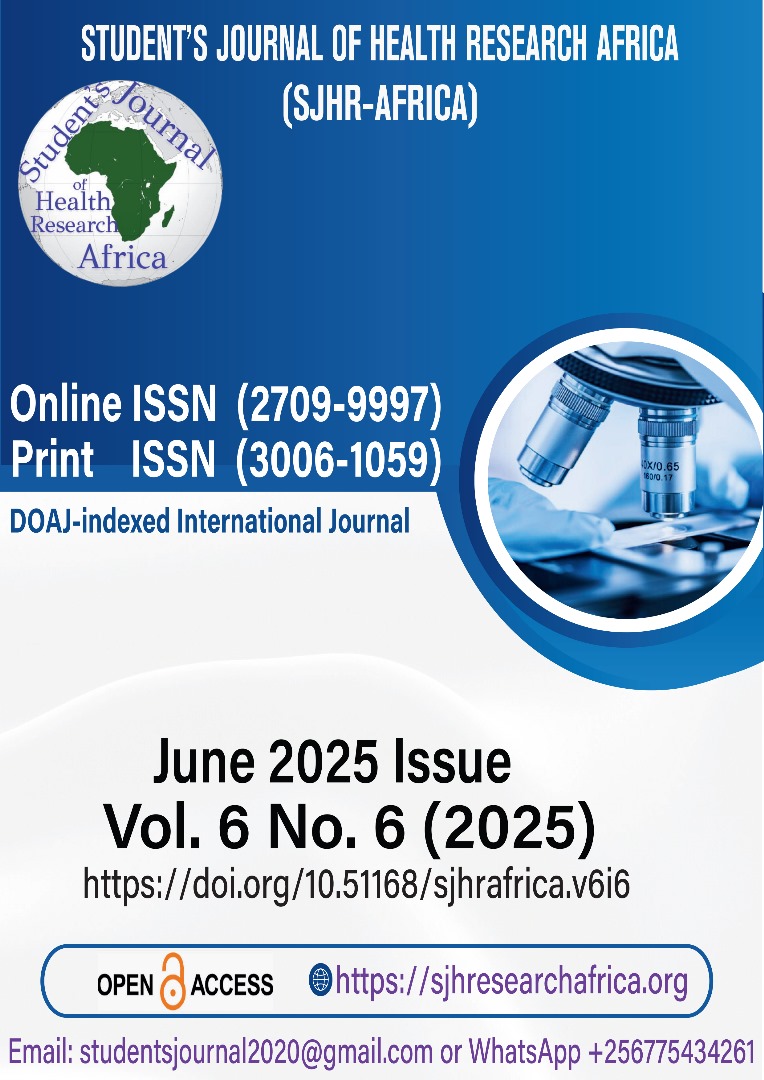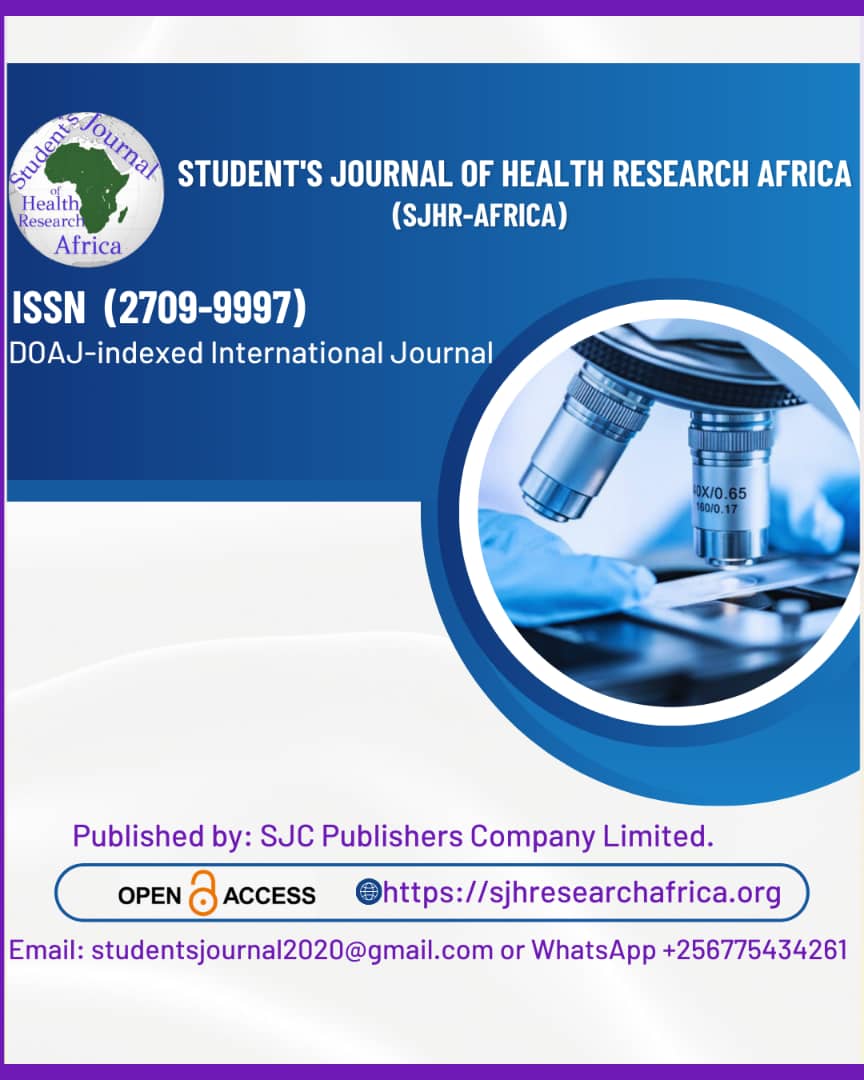Clinical and Bacteriological profile of Participants suspected with SBP in chronic liver disease coming in IGIMS Emergency, Patna
DOI:
https://doi.org/10.51168/sjhrafrica.v6i6.1736Keywords:
Chronic liver disease (CLD), Bacterial infection, Clinical profile, E. coli, OutcomesAbstract
Background
Chronic liver disease (CLD) affects individuals of all ages, sexes, geographical locations, and ethnicities worldwide. Although the rate of progression and clinical course may vary, various etiological factors contribute to a similar clinicopathological pathophysiology in CLD.
Objectives
This study aimed to determine the bacterial profile, laboratory parameters, and clinical presentation of spontaneous bacterial peritonitis (SBP) and assess how these factors influence the outcomes of patients with CLD.
Materials and Methods
This retrospective, cross-sectional, observational study was conducted at Indira Gandhi Institute of Medical Sciences (IGIMS), Patna, Bihar, India, over a period of 18 months. A total of 160 patients were enrolled in the study. Case records of patients aged 18 years and older, diagnosed with SBP, were retrieved from the hospital's electronic database and included in the study.
Results
Relevant gram-positive and gram-negative bacteria were identified in ascitic fluid and blood samples. Total leukocyte count, creatinine, bicarbonate, and direct bilirubin levels were found to be significantly associated with patient outcomes, including discharge against medical advice (DAMA), mortality, and successful discharge (p-value < 0.001). Among the patients, 16 (10%) had a history of SBP, and approximately 120 (75%) had not received antibiotics in the previous three months.
Conclusion
This study provides valuable insights into the clinical characteristics, laboratory findings, and bacterial profile of SBP in CLD patients. These findings highlight the importance of a multidisciplinary approach to SBP management and contribute to the growing body of knowledge on the condition.
Recommendations
The results of our investigation highlight the need for further research on geographical variations in the bacterial profile and clinical presentation of SBP, as well as the development of early diagnostic techniques and appropriate treatment plans.
References
Schuppan D, Afdhal NH. Liver cirrhosis. The Lancet. 2008 Mar 8;371(9615):838-51. https://doi.org/10.1016/S0140-6736(08)60383-9
Cheemerla S, Balakrishnan M. Global epidemiology of chronic liver disease. Clinical liver disease. 2021 May;17(5):365-70. https://doi.org/10.1002/cld.1061
Piano S, Singh V, Caraceni P, Maiwall R, Alessandria C, Fernandez J, Soares EC, Kim DJ, Kim SE, Marino M, Vorobioff J. Epidemiology, predictors and outcomes of multi-drug resistant (MDR) bacterial infections in patients with cirrhosis across the world. Final results of the "Global study". Digestive and Liver Disease. 2018 Feb 1;50(1):2-3. https://doi.org/10.1016/j.dld.2018.01.007
Shizuma T. Spontaneous bacterial and fungal peritonitis in patients with liver cirrhosis: A literature review. World journal of hepatology. 2018 Feb 27;10(2):254. https://doi.org/10.4254/wjh.v10.i2.254
Marciano S, Diaz JM, Dirchwolf M, Gadano A. Spontaneous bacterial peritonitis in patients with cirrhosis: incidence, outcomes, and treatment strategies. Hepatic medicine: evidence and research. 2019 Jan 14:13-22. https://doi.org/10.2147/HMER.S164250
Tay PW, Xiao J, Tan DJ, Ng C, Lye YN, Lim WH, Teo VX, Heng RR, Yeow MW, Lum LH, Tan EX. An epidemiological meta-analysis on the worldwide prevalence, resistance, and outcomes of spontaneous bacterial peritonitis in cirrhosis. Frontiers in Medicine. 2021 Aug 5;8:693652. https://doi.org/10.3389/fmed.2021.693652
Huang CH, Lee CH, Chang C. Spontaneous bacterial peritonitis in decompensated liver cirrhosis: literature review. Livers. 2022 Sep 6;2(3):214-32. https://doi.org/10.3390/livers2030018
Ameer MA, Foris LA, Mandiga P, Haseeb M. Spontaneous bacterial peritonitis.
Alaniz C, Regal RE. Spontaneous bacterial peritonitis: a review of treatment options. Pharmacy and Therapeutics. 2009 Apr;34(4):204.
Paul K, Kaur J, Kazal HL. To study the incidence, predictive factors, and clinical outcome of spontaneous bacterial peritonitis in patients with cirrhosis with ascites. Journal of clinical and diagnostic research: JCDR. 2015 Jul 1;9(7):OC09. https://doi.org/10.7860/JCDR/2015/14855.6191
Paul K, Kaur J, Kazal HL. To study the incidence, predictive factors, and clinical outcome of spontaneous bacterial peritonitis in patients with cirrhosis with ascites. Journal of clinical and diagnostic research: JCDR. 2015 Jul 1;9(7):OC09. https://doi.org/10.7860/JCDR/2015/14855.6191
Mahato T, Sharma Y, Thapa S. Spontaneous bacterial peritonitis among chronic liver disease patients with ascites admitted to the department of medicine of a tertiary care center: a descriptive cross-sectional study. JNMA: Journal of the Nepal Medical Association. 2023 Apr 30;61(260):300. https://doi.org/10.31729/jnma.8124
Nguyen LC, Lo TT, La HD, Doan HT, Le NT. Clinical, laboratory, and bacterial profile of spontaneous bacterial peritonitis in Vietnamese patients with liver cirrhosis. Hepatic Medicine: Evidence and Research. 2022 Jan 1:101-9. https://doi.org/10.2147/HMER.S369966
Downloads
Published
How to Cite
Issue
Section
License
Copyright (c) 2025 Santosh Kumar, Anita, Santosh Kumar Nayan, Abhay Kumar, Siddharth Singh

This work is licensed under a Creative Commons Attribution-NonCommercial-NoDerivatives 4.0 International License.






















